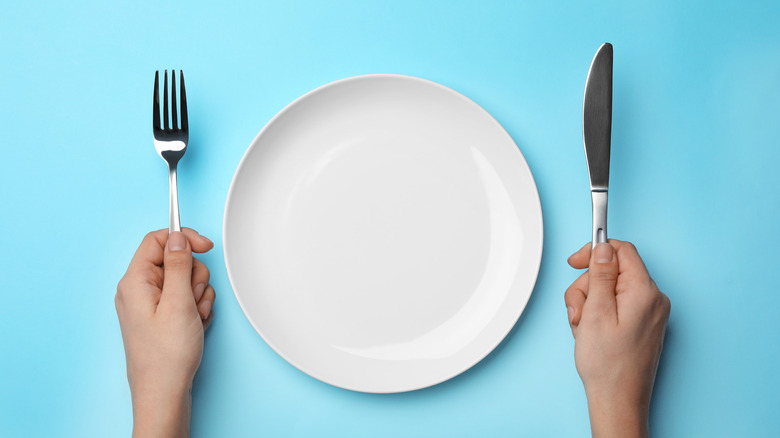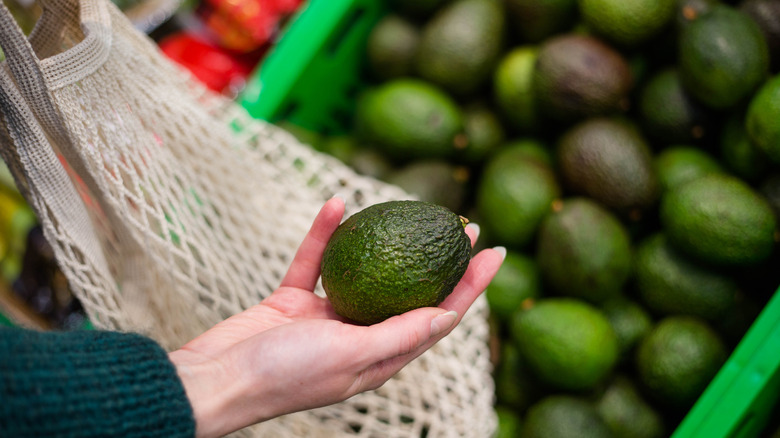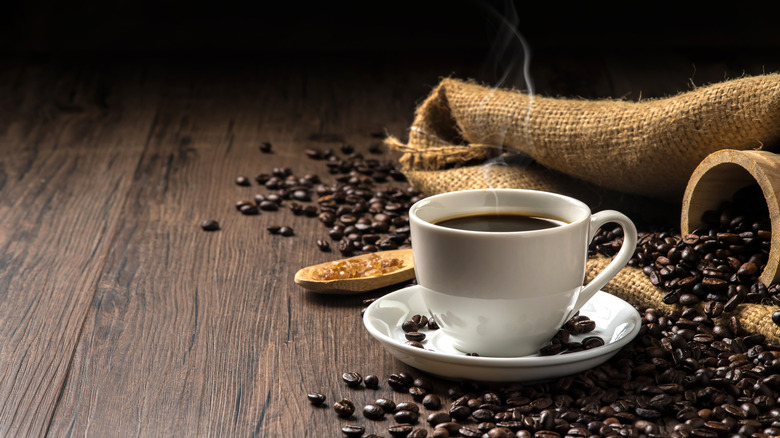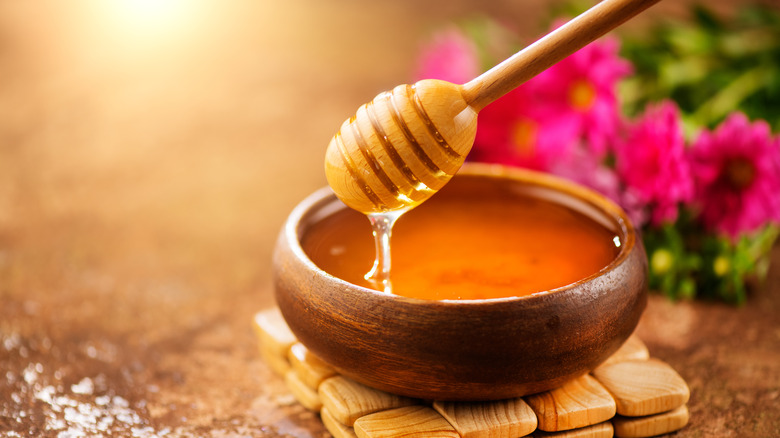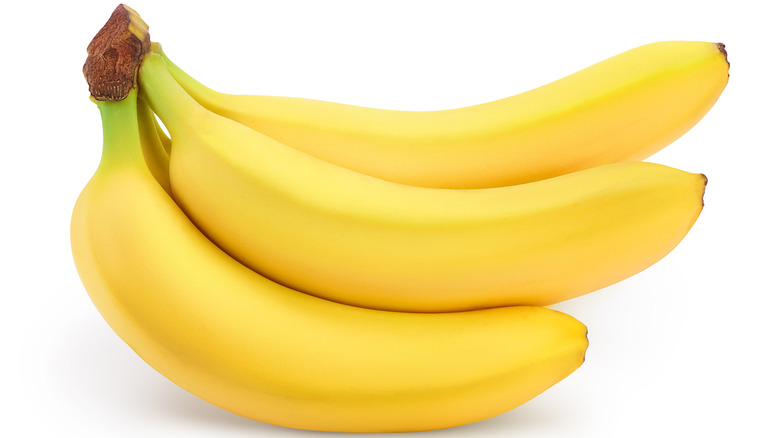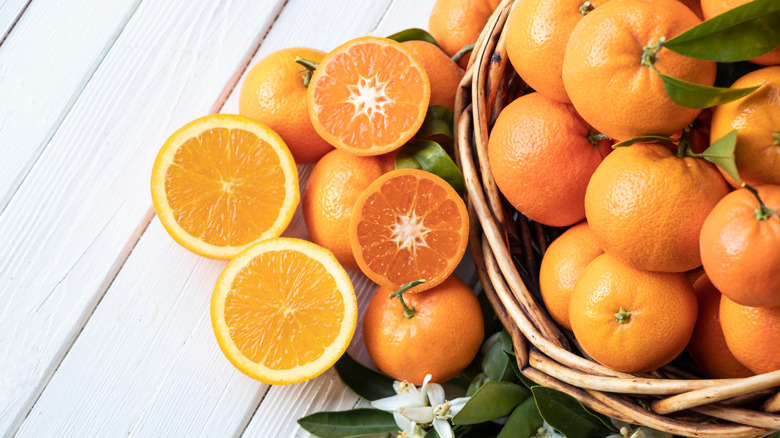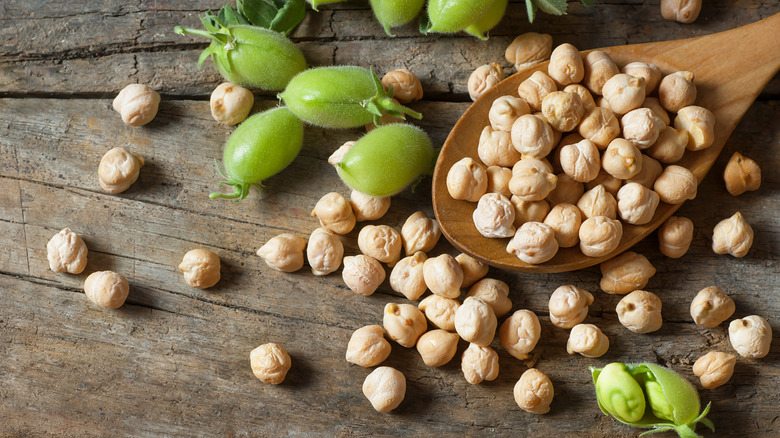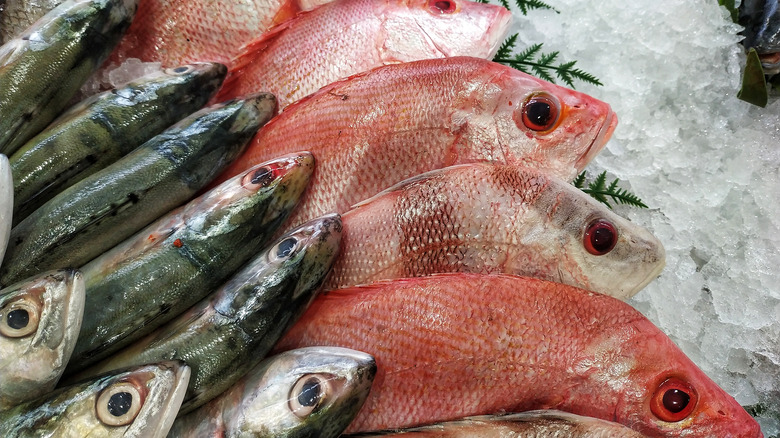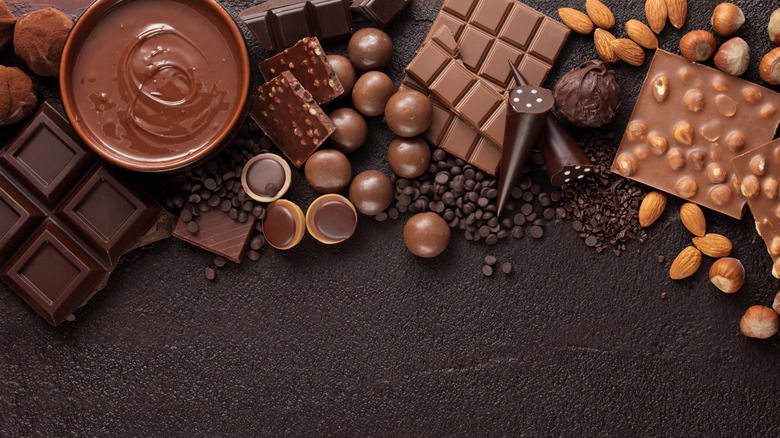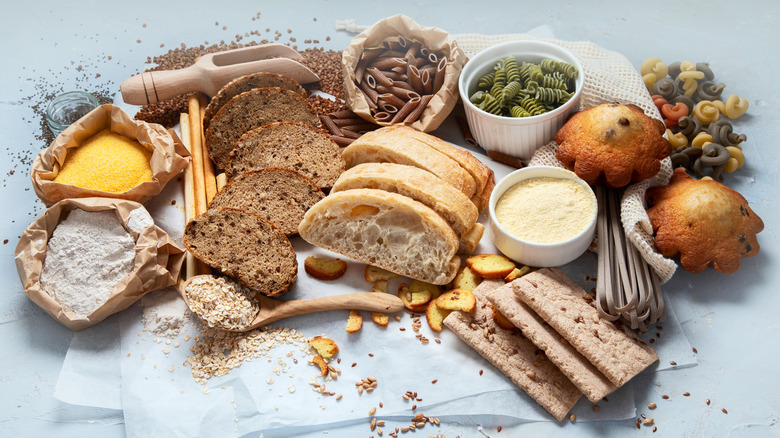Foods We May Not Have Around Much Longer
Can you imagine a morning without bananas on your oatmeal? Without sugar in your coffee? Without coffee? Turns out, that's quite possible. Not only are experts unsure whether or not the current global farmland can sustain the growing world population by 2050, but certain specific foods run the risk of dying out entirely. Due to pests, changes in terrain, and water shortages, these may even reach extinction in our lifetimes. According to one 2019 United Nations report, the world's land and water resources are being exploited at alarming rates, according to The New York Times. Meanwhile, The Guardian, reporting on new research from Aalto University in Finland, notes that a third of global food production will be at risk by the end of the century if things don't change dramatically and soon.
"The potential risk of multi-breadbasket failure is increasing," Cynthia Rosenzweig, a senior research scientist at the NASA Goddard Institute for Space Studies and one of the lead authors of the UN report, told The New York Times. "All of these things are happening at the same time."
It may sound dire, but at least you can prepare yourself for some of the culinary changes that might be coming our way, and soon. Want to know what foods we might have to say goodbye to in the next few decades? Read on.
Wine as we know it
If you enjoy a nice glass of red or white wine with your meal, we've got some unfortunate news to report: climate change is affecting the wine industry all over the world, particularly in regions historically linked to wine production.
In France, for example, the protected designation of origin for the Bordeaux region recently approved six new grapes to join the 14 previously permitted in the protected region. It was all part of an effort to combat the effects of climate change on local winegrowers. The new grapes, which are far from traditional in Bordeaux, much less in France, were selected due to better adaptations to environmental stressors like high temperatures and shorter growing seasons, Food & Wine reports. While this certainly helps winemakers to stay in business, Time notes that it will undoubtedly change the familiar flavors of Cabernet, Merlot, and other beloved French wines.
In Italy's Chianti region, meanwhile, rising temperatures mean the grapes risk overripening, according to The Economist. This can result in an overly sweet (and therefore overly boozy) version of the Italian classic we know and love.
Champagne could vanish from celebrations
One wine region really feeling the climate change burn more than most is Champagne. This northern French region is known for its sparkling Chardonnay, Pinot Meunier, and Pinot Blanc, but the dual oceanic and continental climate the region has long been known for is heating up fast, with noticeable changes for winemakers. In fact, Champagne's 2020 harvest was the earliest known in the region's history, reports Forbes.
As a result of climate change, not only are winemakers forced to pick their grapes earlier, but they have to change their entire historic approach to winemaking, which has been carefully curated and safeguarded through many generations. No longer are new grapes added to wines to add freshness, for instance. Instead, according to fourth-generation Champagne maker Anne Malassagne, interviewed by Pellicle, reserve wines are now necessary to add freshness to the new harvest.
In time, as temperatures begin to climb, some experts believe that sparkling wines from even cooler climes may become superior in flavor to the mighty French stalwart Champagne. That could mean that some surprising wine-producing regions, like England, could come to the fore sooner than anyone may have thought.
Avocados could change dramatically
Gird your guacamole: avocados are probably going to vanish from most restaurant menus soon. But, their disappearance may not be for the reasons you would think.
Unlike a lot of other foods on this list, avocados have actually stood the test of time — literally. According to Smithsonian Magazine, avocados were once a prime food choice for larger land mammals, who could consume the fruit whole, later dispersing the pit the way that smaller mammals do with berry seeds or apple pips. By that logic, the avocado should have gone the way of the mammoth, going extinct when such megafauna died off. But despite these massive animals disappearing almost 13,000 years ago, avocados remain. Unfortunately, that's now somewhat to their detriment.
Most avocados consumed around the world are farmed intensively in Mexico, causing environmental damage like deforestation and habitat destruction, according to the World Economic Forum. Their production also consumes a massive 9.5 billion liters of water every day, a serious concern in a world where water consumption and access are a growing concern. It's no surprise that sustainably-minded consumers are swearing off the once fan-favorite fruit.
Some scientists nevertheless remain committed to conserving this ancient fruit. One group of researchers at the University of Queensland have successfully frozen avocado plant cuttings in nitrogen and then brought them back to life. That's an achievement that, according to CGTN, basically guarantees that we'll never run out of avocados on our planet, though they may still get scarce.
Arabica coffee is facing extinction
Reports of the effects of climate change on coffee cultivation are nothing new. Some studies suggest that about half of the land currently used for coffee production will no longer do the job by 2050, reports the BBC. In 2019, researchers in the UK estimated that almost two-thirds of the 124 known coffee species were at risk of extinction. The most important among them? Arabica.
Most coffee around the globe is made with one of two distinct species of bean: Arabica or Robusta. Arabica, generally acknowledged as the tastier of the two, is a tropical plant hailing from regions like Tanzania and Ethiopia that makes up about 70 percent of all coffee sales worldwide, according to Sustainability Times. But, due to climate change and habitat loss, the land area where Arabica beans currently grow best could be slashed by up to 85 percent in the next several decades. Even worse, according to The Economic Times, Arabica varieties are thought to be more vulnerable to climate change than lower-quality but heat-resistant Robusta.
That said, caffeine addicts need not panic. A prized coffee species has been rediscovered in West Africa for, decades after it supposedly went extinct. Coffea stenophylla, reports The Economic Times, thrives in average yearly temperatures of around 77 degrees Fahrenheit as compared to the 66 preferred by Arabica. More importantly, it is on par in terms of flavor quality, something that Smithsonian Magazine says is rare for wild cultivars.
Honey and other pollinated goods are facing a crisis
If you haven't heard the bees are dying, well, let us kindly ask: have you been living under a rock? Reports of widespread bee death have been all but ceaseless in the past few years, with reports blaming everything from Monsanto's liberal use of insecticides to the effects of cell phone towers (via Global Research).
To be fair, some of those ideas are little more than an unproven rumor, but the issue of disappearing bees is a real and documented problem. In reality, bee death is linked to numerous things including the widespread use of neonicotinoid pesticides and loss of habitat. And if it continues, it will mean a lot more than just a honey shortage.
Bees are natural pollinators, an essential part of the ecosystem that provides us with everything from apples to strawberries to cinnamon. According to the University of Arkansas Division of Agriculture, honey bees perform more than 80 percent of the pollination of more than 100 different cultivated crops. Indeed, honey bees are responsible for an added $15 billion in economic potential for the U.S. every year, thanks to their key role as pollinators. Without bees, many of these crops will be in big trouble, and if they don't go extinct, they'll definitely be in short supply and therefore will likely become a whole lot pricier.
Bananas might get very scarce
Bananas are at risk ... and this isn't even the first time. Today, a species of banana known as the Cavendish makes up about 95 percent of the international trade in bananas and half of the bananas produced worldwide, according to FoodNavigator. It is currently under attack from a disease known as Tropical Race 4, as known as Panama Disease. In the 1950s, the same pest destroyed the entire harvest of the then-popular Gros Michel banana, which had better texture and flavor than the Cavendish but was replaced by the more resilient cultivar. This, by the way, is why banana candy doesn't taste like bananas, says Science Friday, since it's based on a variety we don't have around anymore.
Strides are being taken to develop a genetically modified (GM) banana that can withstand this fungus, particularly in Australia, where researchers announced a new GM banana resistant to the disease in February. However, the crop still remains at risk. Following an outbreak of the fungus in Colombia in 2019, Slate reports, evidence of it has been uncovered in Peru and Venezuela.
Slate cautions that GM crops might be only a temporary measure to address the pest problem. Monocultures of nearly identical crops like bananas reduce biodiversity, open plants up to devastating pathogens, and do not contribute to long-term resilience or environmental health on the whole. Until agricultural scientists are really leaning hard into the banana problem, these fruits could become pretty scarce in the future.
Non-GMO citrus could fade away
Oranges, lemons, grapefruit, and other citrus fruits are under threat from the growing threat of diseases like citrus canker and a bacterial infection known as greening (via The Nation). And greening is a pretty big deal in particular. Modern Farmer notes that it risks devastating the entire American citrus crop, particularly in the citrus-rich orchards of Florida. The University of Florida reports that, in the state, orange production dropped by half between 2005, when the disease was first detected, and 2015. And in 2021, yields were even less than what the Florida News Times reports was already expected to be the lowest harvest in decades.
The disease has also hit Southern California, where farmers have nevertheless been able to halt its devastation it using a combination of coordinated crop protection treatments and reliance on local parasites and predators that, as AgriPulse reports, can help diminish even successful invasive pests by using them for food.
One possible solution to the disease is in development at the University of California, Riverside, where researchers isolated a greening-resistant peptide found in the Australian finger lime, which they can then inject into sick trees with some promising results. But research is ongoing and the greening threat still remains, meaning that the American citrus industry is far from in the clear.
Chickpeas are being hit with serious growing issues
Chickpeas, also known as garbanzo beans, appear on many a vegan menu. Indeed, they are fairly synonymous with modern sustainable, gluten-free, and plant-based lifestyles. They're also pretty darn good for you, forming a rich source of protein, fiber, iron, and other nutrients. But hummus fans may have to say bye-bye to their favorite protein-rich dip, as chickpea crops have been fairly devastated of late due to Ascochyta blight, a disease that regularly destroys a portion of Australia's production of the pulse every year.
Local pathologists are attempting to find a solution to this issue by looking into wild relatives of the chickpea. Chickpeas as they're currently bred for agricultural purposes aren't especially diverse, genetically speaking, as EurekAlert reports. However, it looks as if their wild cousins are naturally resistant to the blight. They could therefore provide the key to eradicating this disease via genetic modification, gene editing, or cross-breeding with chickpea plants. Yet, if tests bear no fruit, literally and figuratively speaking, it's possible that things like chickpea pasta and roasted chickpea snacks will be nothing more than things of the past in our near future.
Fish is maybe getting too popular
You may already be aware of the rampant issues related to fishing worldwide, with many popular big-name items like tuna being deemed unsustainable due to overfishing. According to NOAA Fisheries, 20 percent of all known fish stocks are overfished, jeopardizing their ability to support sustainable fishing practices that could keep the seafood section of your local grocery properly stocked. And despite efforts to reduce overfishing across the globe, NOAA's 2020 Status of Stocks report has some unfortunate news to share.
The report shows a significant recent increase in overfishing in the U.S. over 2020, with four new fish stocks added to the overfished list in that year alone. Eight stocks that had been previously successfully rebuilt, meanwhile, returned to the overfished territory, according to GreenBiz. At this rate, it seems very possible that some of these popular fish may soon become unavailable. That means that they'll become scarce not just to diners who love them, but to communities who rely on them as a source of essential protein and micronutrients, not to mention those that rely on fishing as a way of life.
Chocolate might look very different
Some reports that the world was going to run out of chocolate by 2050 were vastly over-exaggerated, says USA Today. The hubbub arose in 2018 after Business Insider misconstrued the purpose behind a research project conducted at UC Berkeley and the Mars corporation. However, while fans of these sweets may breathe more easily, for now, the sad truth is that chocolate is indeed at risk due to climate change.
According to a study from R2Water Research and Consultancy and Vrije University in the Netherlands, climate change vulnerability in cocoa-producing nations like Indonesia and Malaysia is expected to become a truly serious issue by 2050. And, in less than 30 years, it's possible that 28 percent of cocoa imports will come from these highly vulnerable regions — meaning that the chocolate they produce could become very scarce if issues like drought or rising temperatures affect crops.
Luckily, there are some folks working on a solution in Switzerland, where a lab in Zurich recently developed innovative lab-grown chocolate. Tilo Hühn, the mastermind behind the idea, says that the new chocolate is meant to be made under "conditions that don't take up so much of the environment and leave a very light footprint," both from a climate and a social point of view, per Wonderful Engineering. That said, it won't taste exactly the same as regular chocolate, notably lacking some of the unique fruitiness of the real thing.
Bread, pasta, and beer could almost disappear
Fans of high-carb foods are in for a rude awakening, as the world's wheat production could very well come under a massive threat in the near future. On average, according to research from Harvard University, wheat and wheat products make up a whopping 20 percent of our species' caloric intake. This means that extreme droughts decimating wheat harvests could have quick and potentially devastating effects on diets worldwide. And, given the increasing environmental pressures produced by climate change, those effects could make themselves known on your plate sooner rather than later.
In the U.S. specifically, according to one 2021 study published in PLoS ONE, increasing global temperatures are a major factor contributing to losses in winter wheat production yields. Climate change, the study shows in no uncertain terms, is to blame for putting not just bread, but also pasta, pizza, pancakes, doughnuts, cereals, and some wheat-reliant beers at risk. If nothing else, consumers could expect to see price increases for what had once been considered staples of the dinner table. If climate change continues at its current pace, these and other widespready culinary favorites could soon be in short supply.
